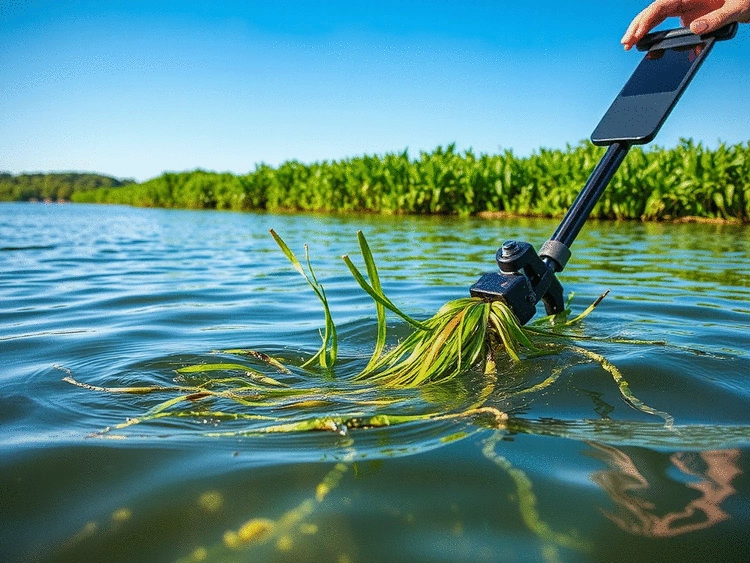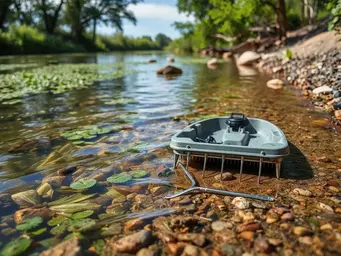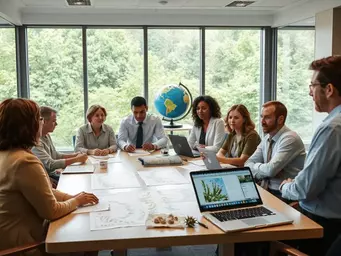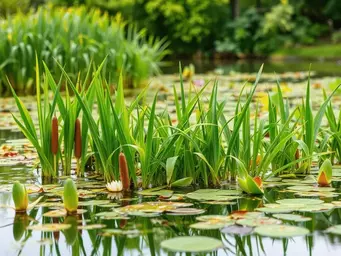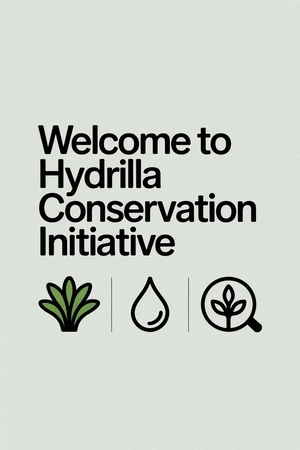As the fight against invasive species like hydrilla continues, understanding effective management strategies is more important than ever. How can we balance human activities with the need for ecological preservation? Let's explore essential insights that will empower you to take action!
What You Will Learn
- Hydrilla's rapid growth can severely disrupt local ecosystems by outcompeting native plants and degrading water quality.
- Mechanical control methods offer immediate results and minimize chemical use, making them a sustainable option for managing hydrilla.
- Community involvement in hydrilla management fosters environmental stewardship and raises awareness about local aquatic ecosystems.
- Regular monitoring and assessment of control methods are crucial for adapting strategies and ensuring the health of waterways.
Hydrilla Control Strategies: A Comparative Overview
This visual outlines key aspects of hydrilla management, distinguishing between its problematic characteristics and the benefits of mechanical control methods.
Problematic Aspects of Hydrilla
- ✖ Displacement of Native Species: Reduces biodiversity.
- ✖ Water Quality Degradation: Causes oxygen depletion.
- ✖ Recreational Impacts: Hinders boating, fishing, swimming.
Benefits of Mechanical Control
- ✔ Immediate Results: Quick relief from infestations.
- ✔ Minimal Chemical Use: Reduces unintended consequences.
- ✔ Community Engagement: Fosters stewardship and awareness.
Understanding Mechanical Control of Hydrilla: An Introduction
In the intricate world of aquatic ecosystems, hydrilla (Hydrilla verticillata) stands out as one of the most troublesome invasive species. Often mistaken for benign water plants, hydrilla's rapid growth can choke waterways, disrupt local habitats, and threaten the survival of native species. The New York State Department of Environmental Conservation provides further insights into the comprehensive management plans being implemented to combat its spread, which highlights the serious impact of such invasive species.
Have you ever encountered a lake or pond overrun with dense vegetation? This is the result of hydrilla's propensity for aggressive spread. Its ability to form thick mats on the water’s surface can block sunlight, which ultimately hampers the growth of beneficial aquatic plants and alters the ecological balance. Understanding hydrilla is crucial for anyone involved in environmental management.
What is Hydrilla (Hydrilla verticillata) and Why Is It Problematic?
Hydrilla is a submerged perennial plant that can grow in various conditions, from still to flowing waters. Its distinctive whorled leaves and rapid reproduction through fragmentation make it particularly challenging to manage. In fact, a small fragment of hydrilla can give rise to new plants, exacerbating the invasion. The New York City Department of Environmental Protection offers a detailed hydrilla management plan, emphasizing its problematic nature and the need for organized control efforts.
- Displacement of Native Species: Hydrilla can outcompete native aquatic plants, diminishing biodiversity.
- Water Quality Degradation: Dense mats can lead to oxygen depletion, harming fish and other aquatic life.
- Recreational Impacts: Boating, fishing, and swimming can become difficult or impossible in heavily infested areas.
Therefore, effective management strategies are vital to mitigate these impacts. As the founder of the Hydrilla Conservation Initiative, I am passionate about empowering professionals with the right tools to combat this invasive threat.
The Importance of Mechanical Control Methods in Aquatic Ecosystems
Mechanical control methods play a pivotal role in managing hydrilla. By using physical techniques to remove the plant, we can reduce its prevalence without relying solely on chemical treatments. This not only helps maintain ecological integrity but also promotes public support for management initiatives. The U.S. Army Corps of Engineers has also recognized the importance of such methods, outlining strategic environmental assessments for hydrilla management in crucial waterways like the Connecticut River.
- Immediate Results: Mechanical removal can provide quick relief from hydrilla infestations, allowing for immediate improvement in water quality.
- Minimal Chemical Use: Using mechanical methods limits the need for herbicides, which can have unintended consequences on non-target species.
- Community Engagement: Involving local communities in physical removal projects fosters a sense of stewardship and awareness about aquatic ecosystems.
As we explore the various mechanical removal techniques in the following sections, we aim to provide actionable insights that can empower you to take control of hydrilla in your local waterways. Let’s dive deeper into effective strategies that can make a difference!
Quick Summary
Here's a brief recap of the key points discussed so far:
- Hydrilla is a highly invasive aquatic plant that disrupts local ecosystems.
- Mechanical control methods offer immediate relief and promote community engagement.
- Effective management strategies are essential for restoring ecological balance and protecting native species.
Frequently Asked Questions About Hydrilla Control
- Q: What makes hydrilla such a problematic invasive species?
- A: Hydrilla is problematic due to its rapid growth, ability to form dense mats that block sunlight, displacement of native species, degradation of water quality through oxygen depletion, and obstruction of recreational activities like boating and fishing.
- Q: What are the main benefits of using mechanical control methods for hydrilla?
- A: Mechanical control methods offer immediate results, minimize the need for chemical herbicides which can have unintended environmental impacts, and encourage community engagement in environmental stewardship.
- Q: How can communities get involved in hydrilla management?
- A: Communities can get involved through physical removal projects, participating in local workshops and seminars, networking with environmental professionals, and engaging with local universities and research institutions.
- Q: Why is regular monitoring important for hydrilla control efforts?
- A: Regular monitoring and assessment are crucial for tracking changes in hydrilla density, evaluating water quality parameters, gathering community feedback, and determining which techniques are most effective in specific water bodies. This allows for adaptation and optimization of management strategies.
- Q: Where can I find resources and support for implementing hydrilla control strategies?
- A: Resources and support can be found through university extension programs, grants from environmental agencies, partnerships with local conservation organizations, and online databases. Connecting with local experts and reviewing case studies also provides valuable insights.
Conclusion: Making Informed Decisions on Hydrilla Control
As we wrap up our exploration of hydrilla control, it's essential to evaluate the effectiveness of mechanical control methods and the various monitoring techniques available. Understanding these methods is not only beneficial for professionals but also for educators and community members who are keen on making informed decisions. Have you considered how these strategies can fit into your local ecosystem management?
Effective mechanical control of hydrilla involves regular monitoring and assessment of the techniques used. By keeping track of what works and what doesn't, we can adjust our approaches to maximize success. This ongoing evaluation helps in understanding the ecological impact of our actions and ensures that we are making strides toward a healthier waterway!
Evaluating the Effectiveness of Mechanical Control Methods and Monitoring Techniques
- Observe changes in hydrilla density and cover over time.
- Implement regular assessments of water quality parameters.
- Gather community feedback on recreational use and ecological changes.
- Document and analyze which techniques yield the best results in your specific waterbody.
By using these evaluation methods, we can determine the success of the mechanical control efforts and adjust our strategies accordingly. As the founder of the Hydrilla Conservation Initiative, I’ve seen firsthand the importance of this ongoing process in fostering healthy ecosystems. It's about building a comprehensive understanding of our interventions and their impacts.
Final Thoughts on Sustainable Hydrilla Management and Ecosystem Restoration
Embracing sustainable hydrilla management requires a holistic perspective. We must recognize the interconnectedness of our aquatic ecosystems and the pivotal role hydrilla plays within them. Effective management is not solely about removal but also about understanding and promoting ecosystem recovery. Have you thought about how your local practices can contribute to broader environmental health?
Ultimately, the goal of our efforts should be to restore native habitats and ensure the resilience of our waterways. By fostering collaboration among professionals, educators, and community members, we can create a unified front against invasive species like hydrilla. Let’s champion sustainable practices that benefit both our ecosystems and our communities!
Take Action: Implementing Your Hydrilla Control Strategy
Where to Find Resources and Support for Mechanical Control: Funding Sources and Extension Services
Implementing a successful hydrilla control strategy may seem overwhelming, but there are plenty of resources at your disposal! Local extension services, non-profit organizations, and state agencies often provide funding and support to help you tackle hydrilla management effectively. Here are some avenues to explore:
- University extension programs offering workshops and support.
- Grants for aquatic management from environmental agencies.
- Partnerships with local conservation organizations.
- Online databases with resources and tools for best practices.
Accessing these resources can not only enhance your management efforts but also connect you with like-minded individuals who are equally passionate about preserving our aquatic ecosystems. My experience has shown that community involvement is crucial for success!
Connecting with Local Experts and Case Studies in Aquatic Vegetation Management
Don’t go it alone! Connecting with local experts can provide invaluable insights that are tailored to your specific environment. Many communities have case studies showcasing successful hydrilla management, offering real-world examples of what works. Here’s how you can find these connections:
- Attend local workshops and seminars on aquatic management.
- Network with environmental professionals at conferences.
- Engage with local universities and research institutions.
- Participate in online forums and social media groups focused on aquatic conservation.
The more you engage with others in the field, the more knowledge you gain and share. These connections can lead to collaborative efforts, bringing together community members dedicated to restoring our waterways. Together, we can create a sustainable future for our aquatic ecosystems!
Recap of Key Points
Here is a quick recap of the important points discussed in the article:
- Understanding Hydrilla: Recognize hydrilla as an aggressive invasive species that disrupts aquatic ecosystems by outcompeting native plants and degrading water quality.
- Importance of Mechanical Control: Mechanical control methods provide immediate results, limit chemical use, and engage local communities in the management process.
- Regular Monitoring: Continuously assess hydrilla density, water quality, and community feedback to evaluate the effectiveness of management techniques.
- Sustainable Practices: Embrace a holistic approach to control hydrilla, focusing on ecosystem recovery and collaboration among stakeholders.
- Access Resources: Utilize local extension services and community partnerships for support in implementing effective hydrilla management strategies.
